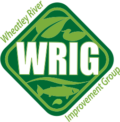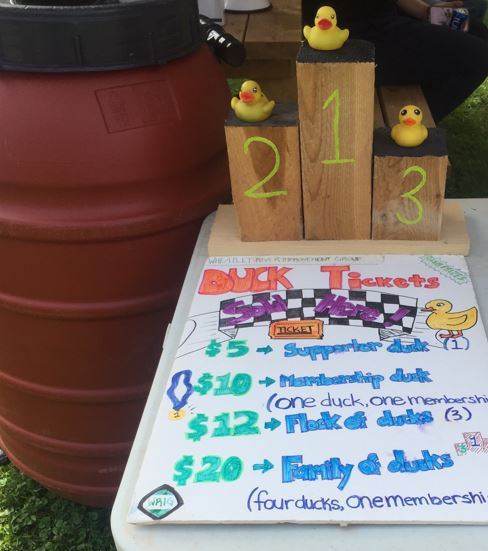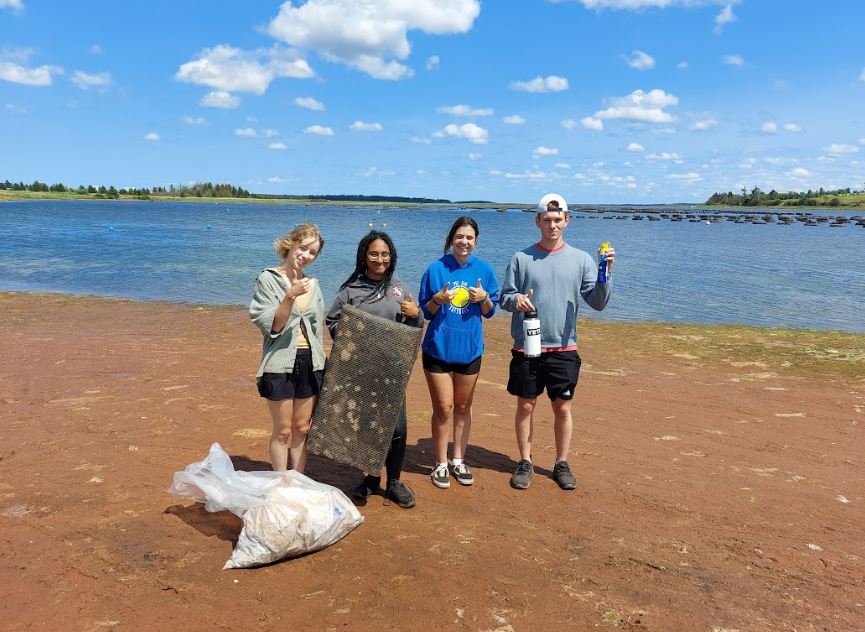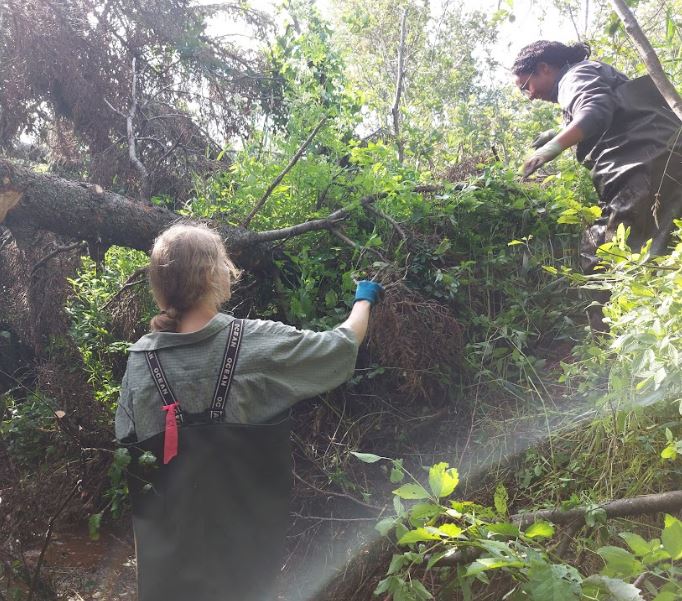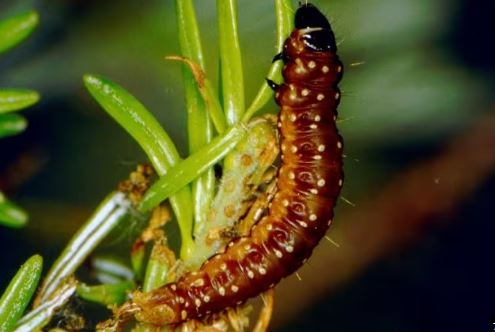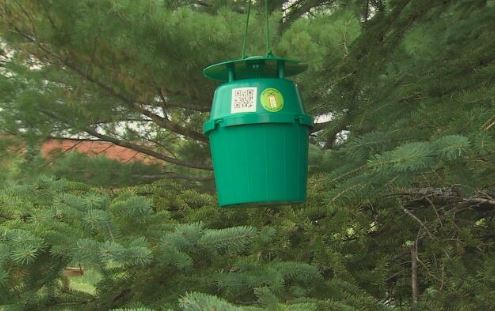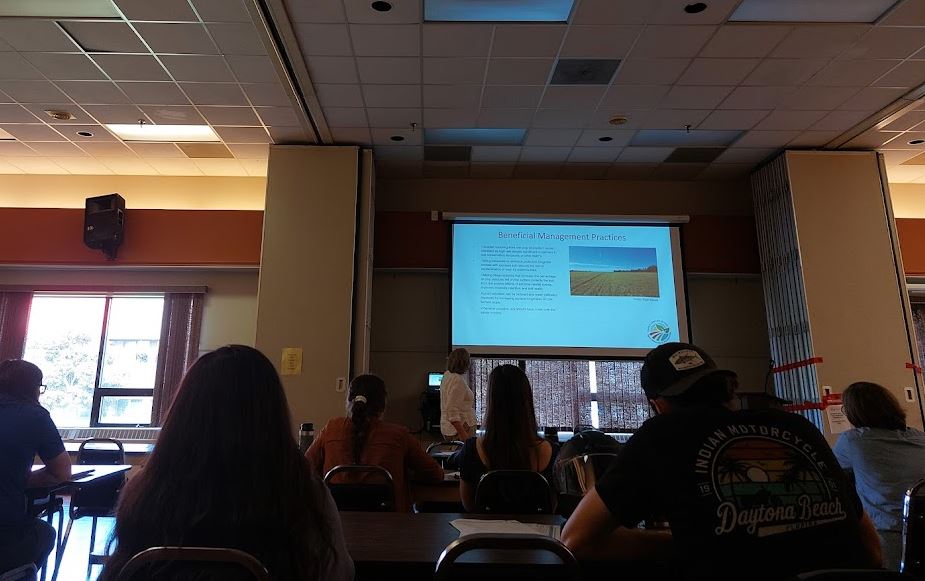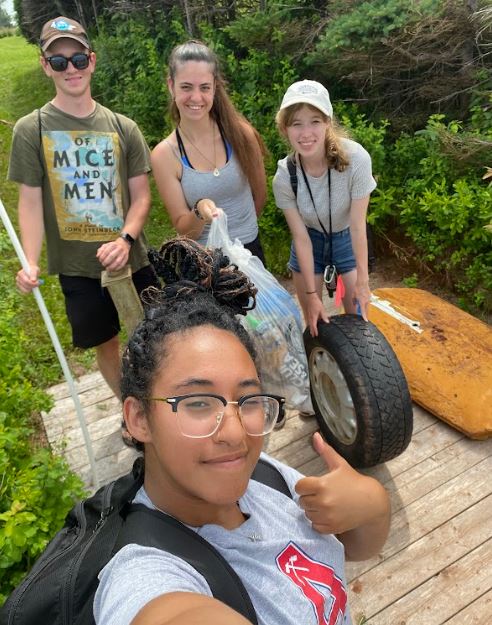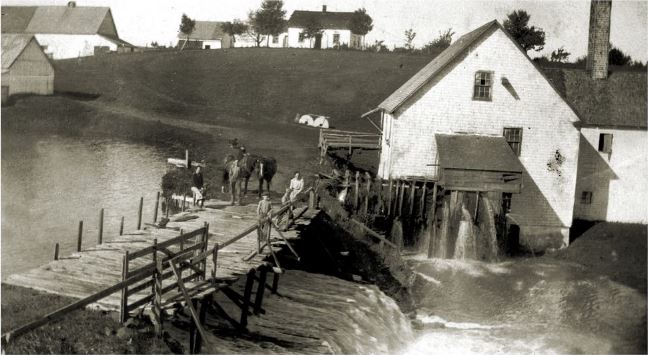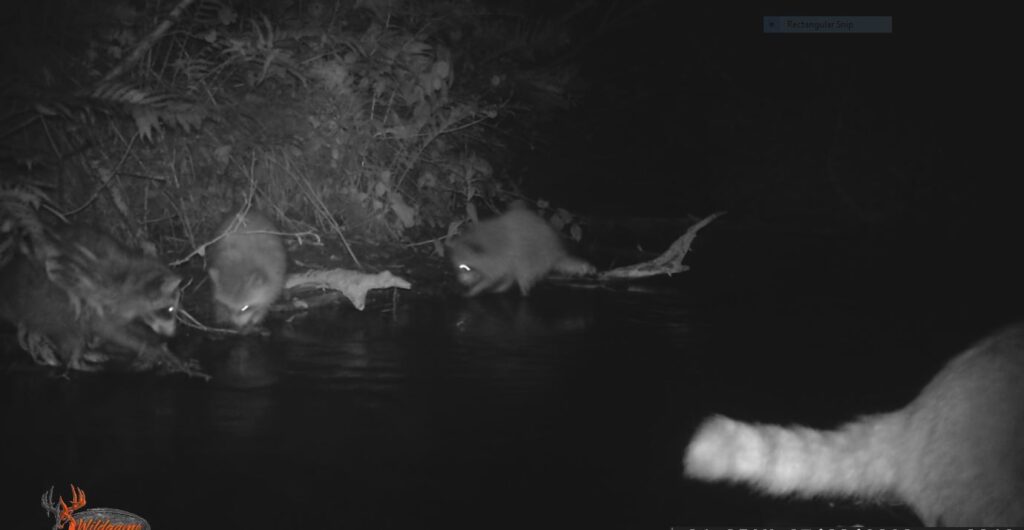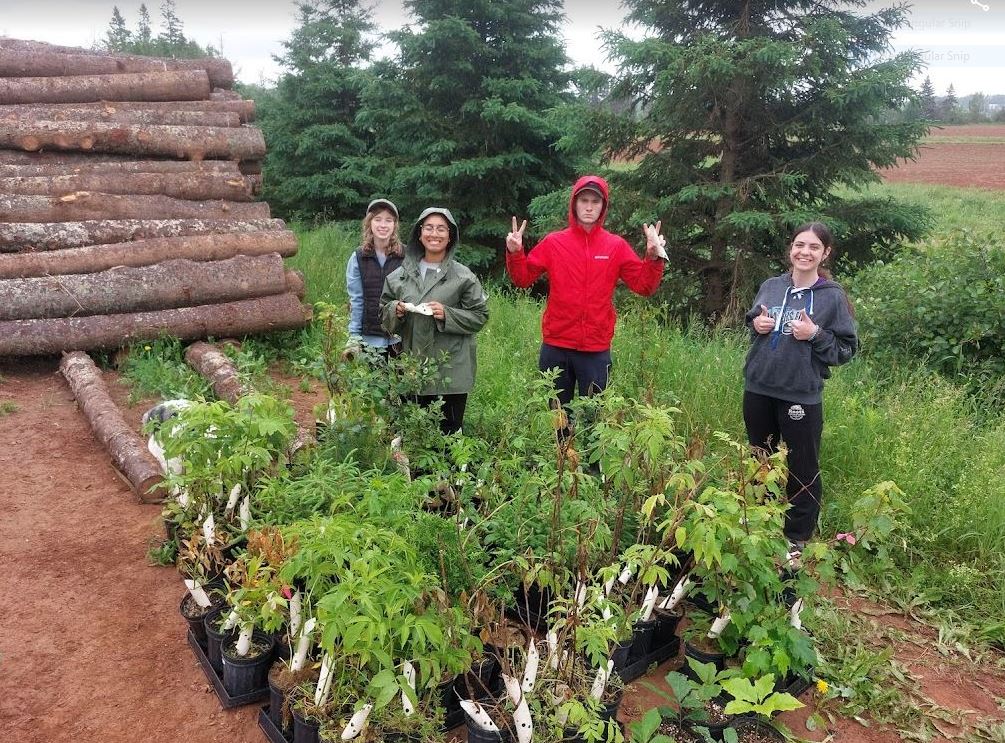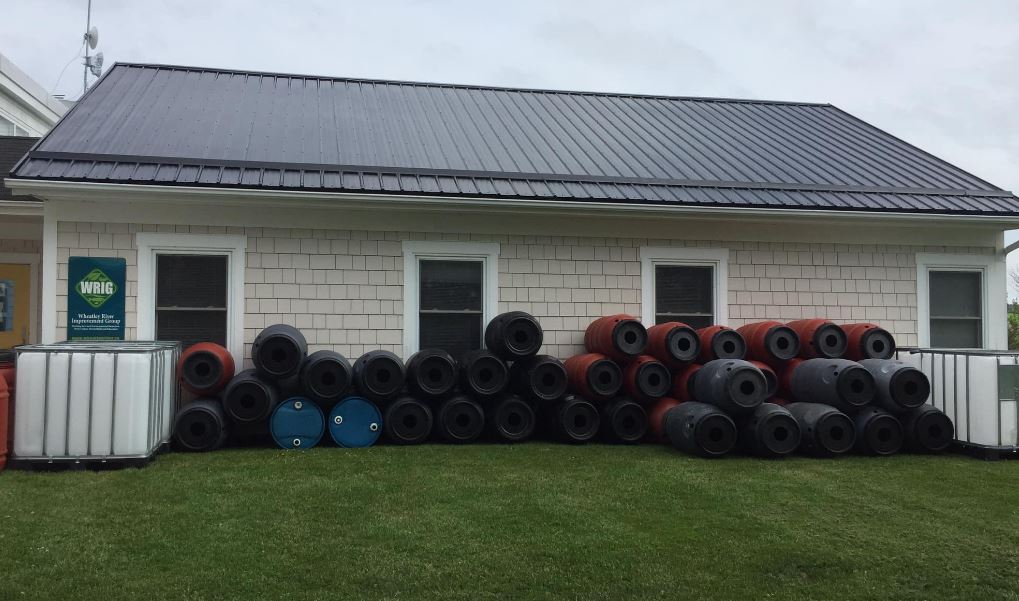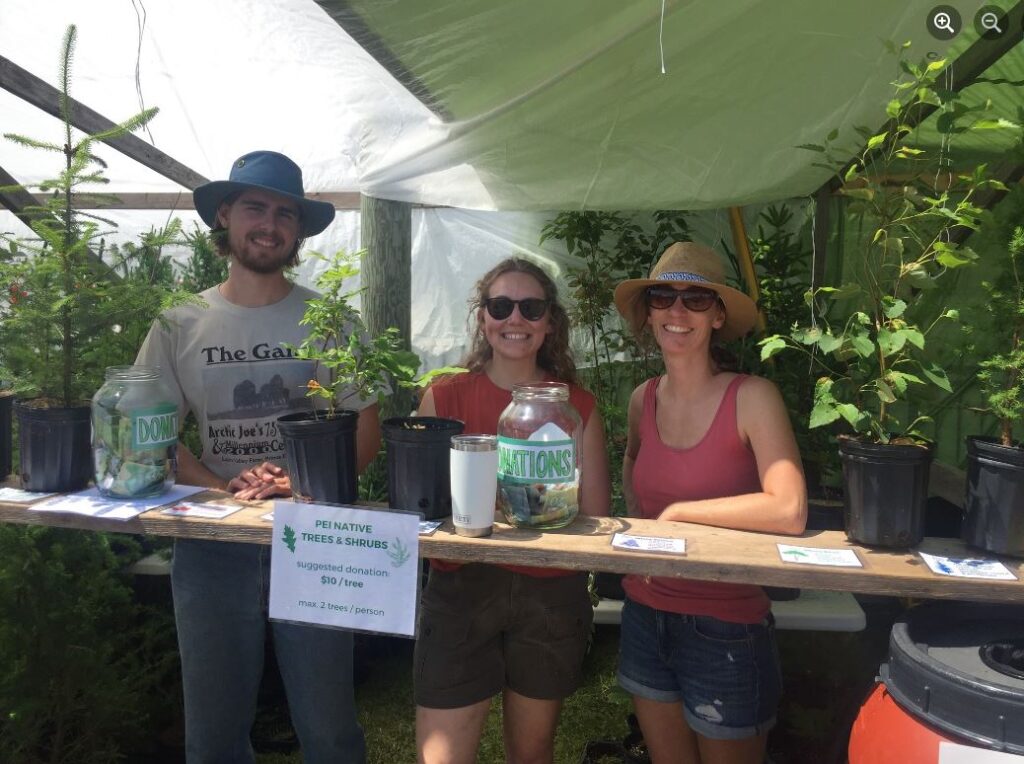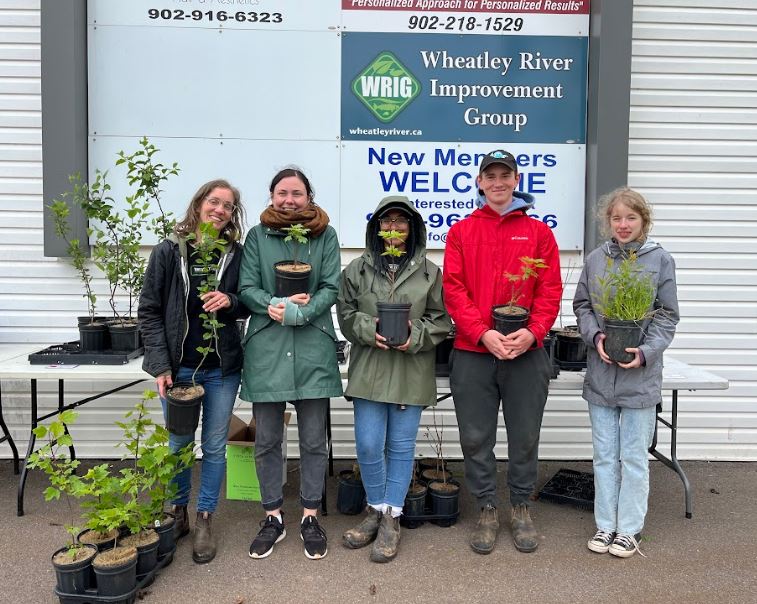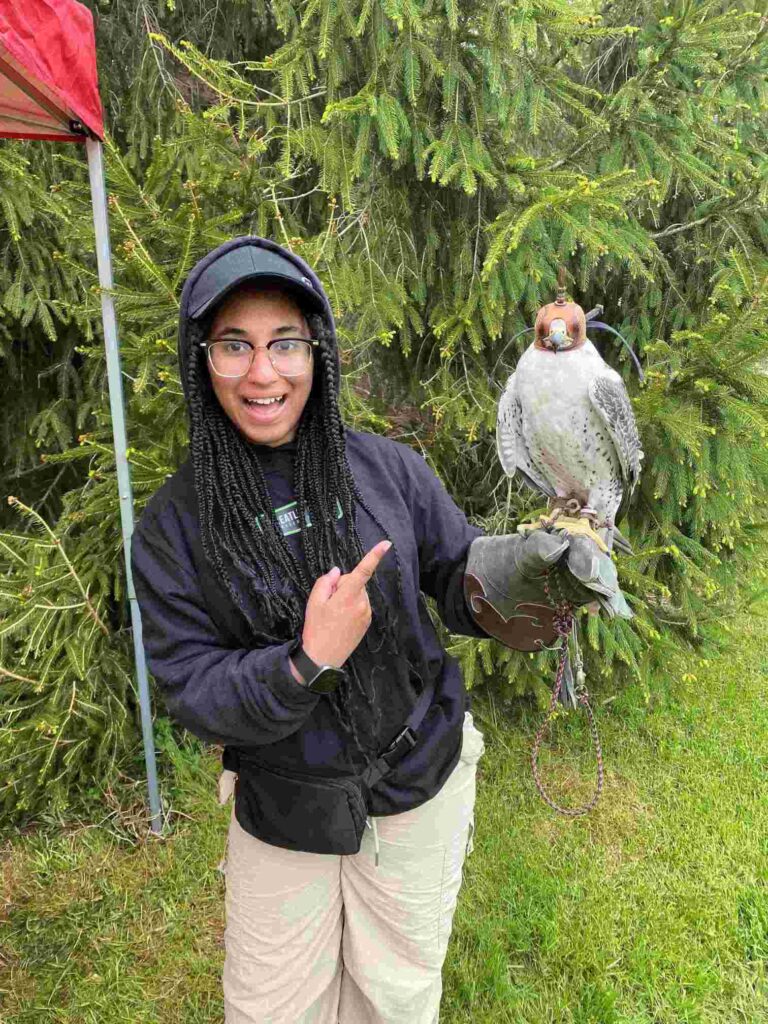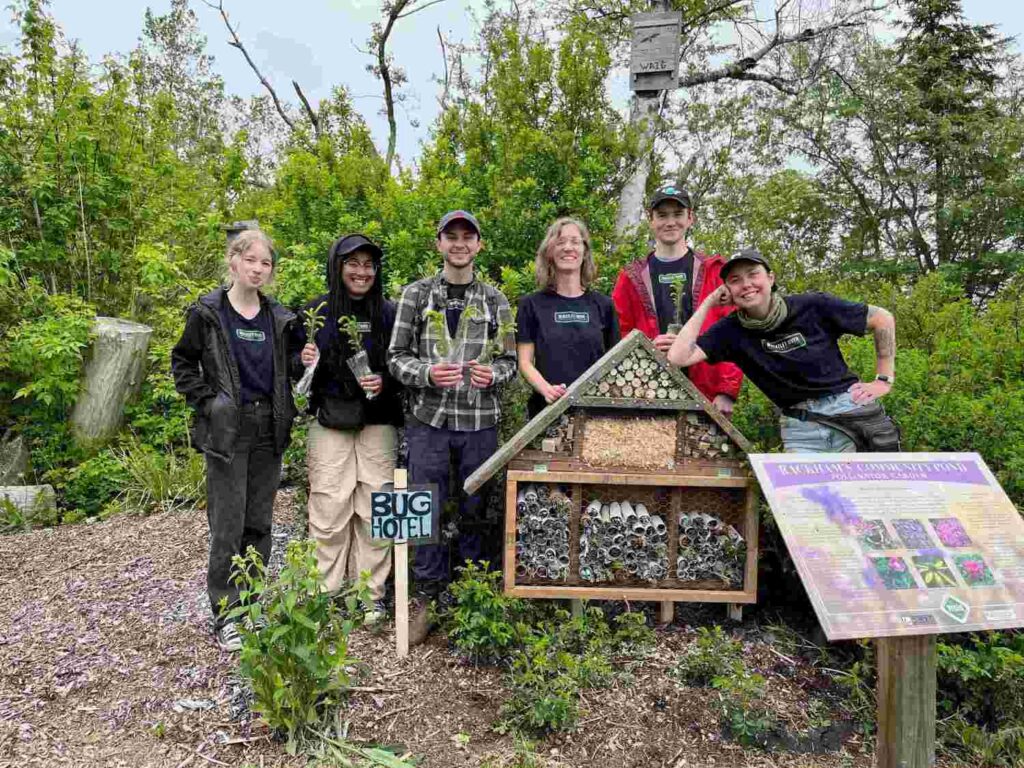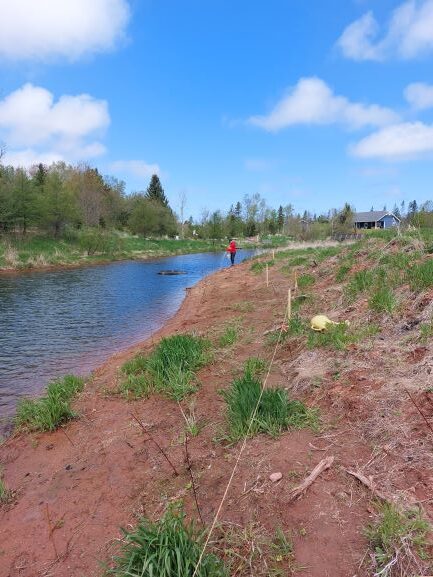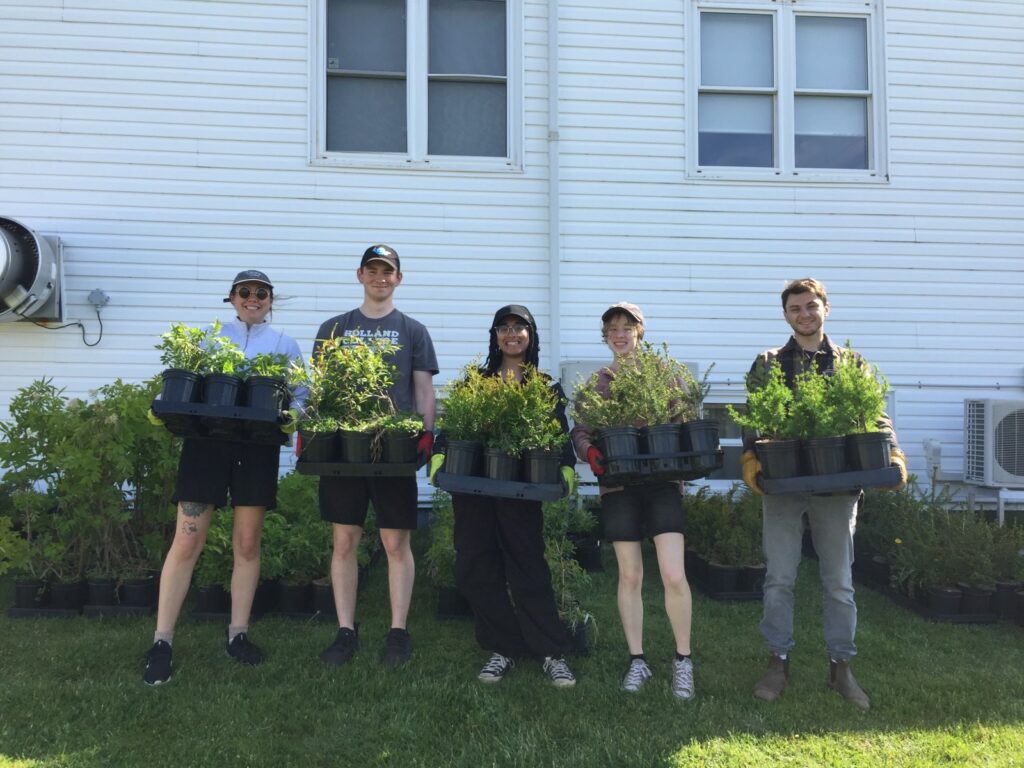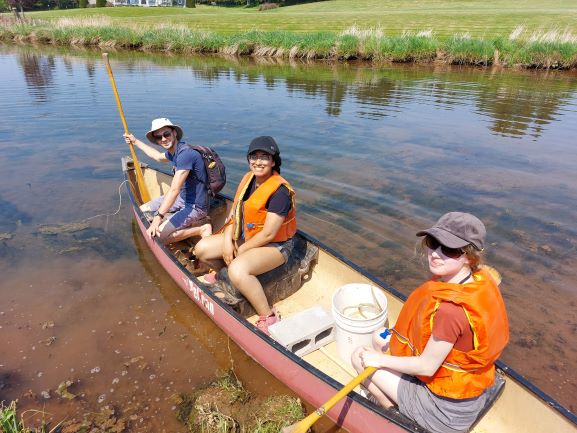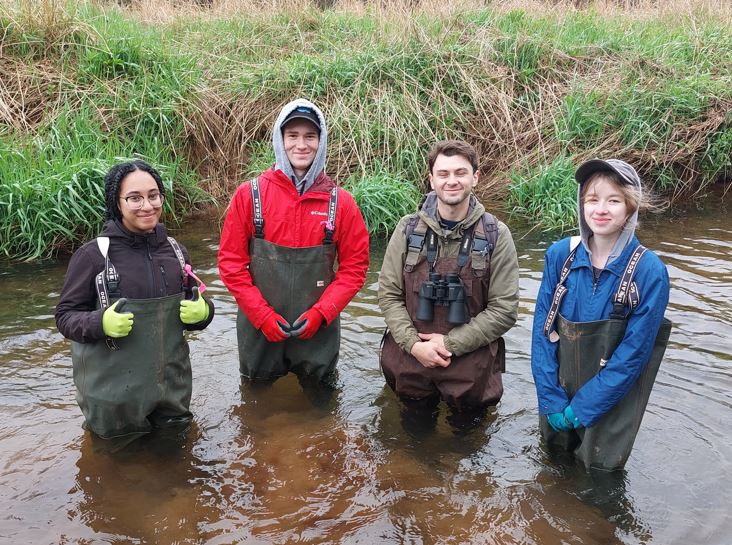WEEK 14: August 21-25
The final week… how did this happen so fast?!
WRIG’s annual duck race came and went! It was a very successful event filled with sunshine and fun. This year community members participated in a Rackham’s Pond scavenger hunt, enjoyed some snacks, and cheered on their rubber duck as it raced towards the finish line around the stream bend. Sending out a big congrats to our 1st place winner, Gabriel!
The crew headed back out to the streams for fieldwork. They constructed more brush mats and added more brush to previous brush mats.
Later in the week, the PEI Watershed Alliance helped WRIG set up wildlife cameras as part of a project that monitors river otters. In the late 1800s river otters were extirpated (locally extinct) from PEI but recently they have been making a return! Trail cameras, or remote cameras, are placed in different watersheds to monitor otters in the area.
The last day was spent out on the Wheatley River. Using a canoe and kayak, the crew spent their final day partaking in anoxia monitoring.
This was a fantastic summer, full of laughs, good times, and hard work. We want to give a big thank you to our great crew for being a part of the WRIG team. We wish you all the best in the future!






WEEK 13: August 14-18
It’s Amber’s last week! The summer flew by and we are sad to know the end of summer work season is near. We made sure to pack this week full of activities and fun.
Monday began with weekly Rackham’s maintenance and checking the footage from the wildlife cameras. Once those tasks were completed, the crew grabbed their tools and twine and headed to the section of stream cleared the previous week. It is the beginning of brush mat construction. The crew used the natural materials that were placed on the upper banks from the stream clearing they had finished last week.
What is a brush mat you might ask?
It is a structure easily built using conifer tree boughs, wooden stakes and twine. The tree boughs are placed into the sediment along the edge of the stream and securely tied to stakes typically made from alders. The boughs catch and trap sediment as it flows by. The crew has had the proper training to know exactly where to place these brush mats along a meandering stream channel, to be efficient at collecting sediment.
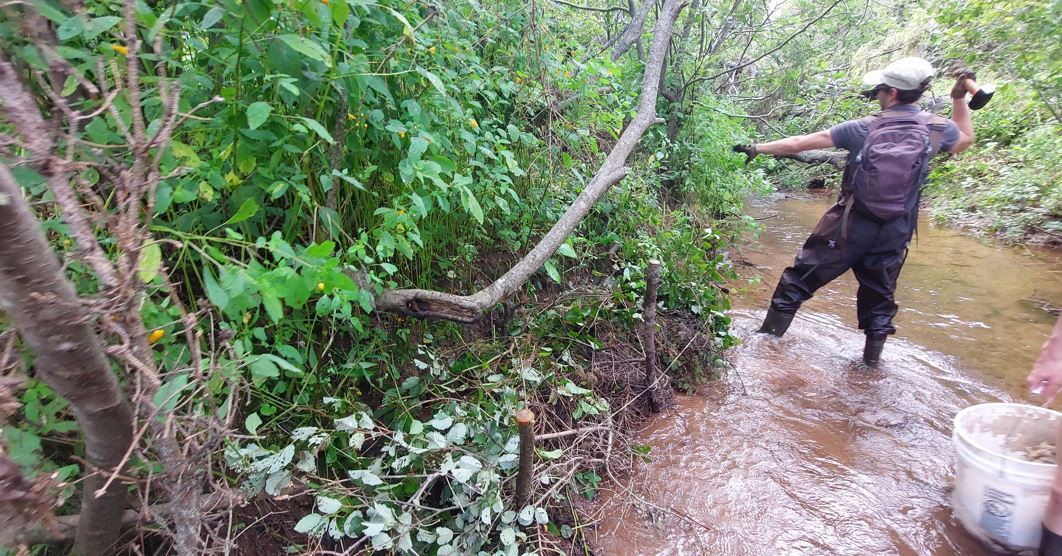
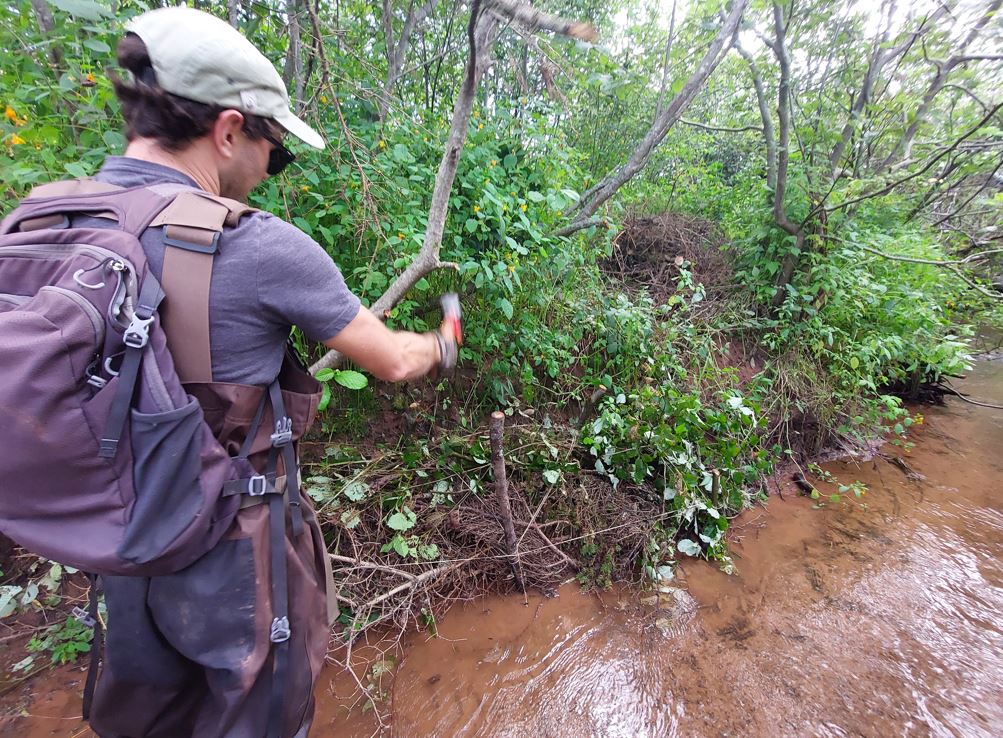
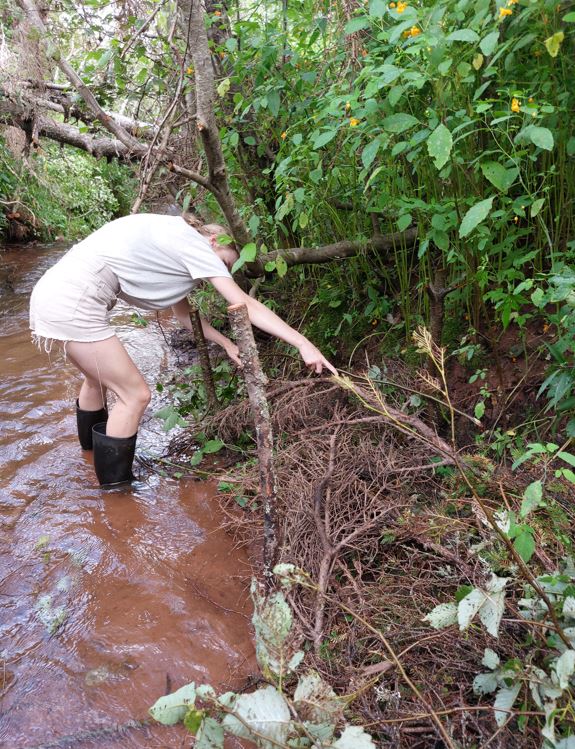
The highlight of the week was when the crew met up with the team from HCWG for their annual deep-sea fishing trip. Excitement was high as everyone successfully reeled in their catch of the day.
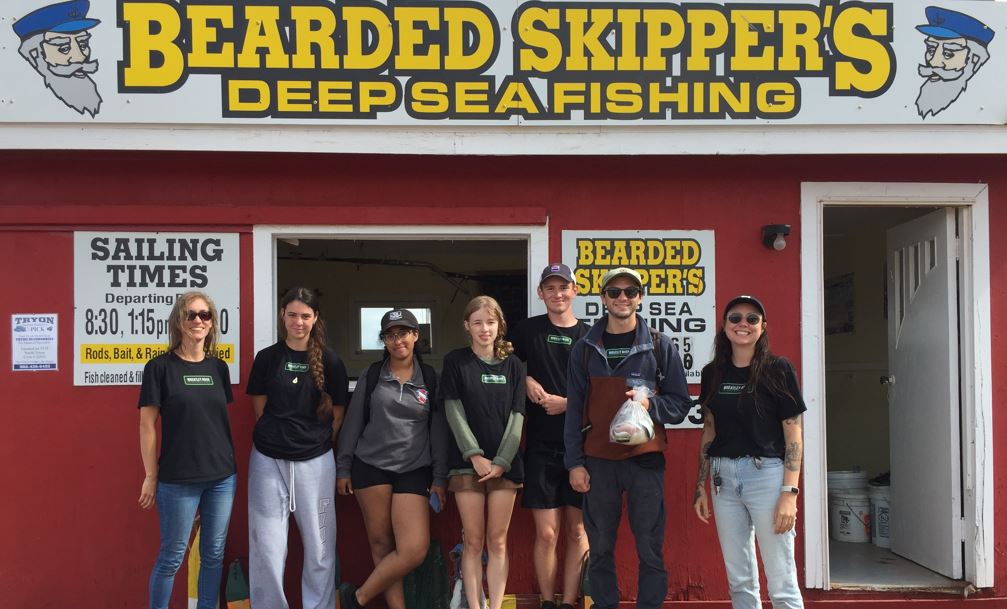
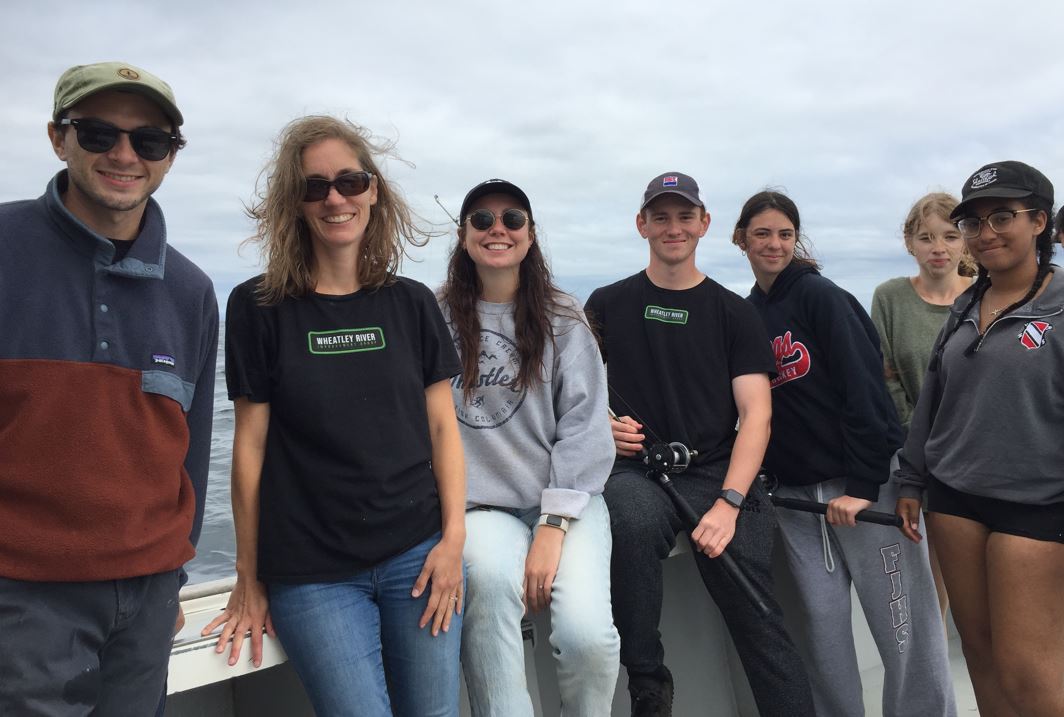
With the fishing trip behind them, preparation for the WRIG’s annual duck race began! The crew worked together and created their crew report poster board, got their rubber ducks in a row, and ensured Rackham’s pond was ready to go!
WEEK 12: August 7-11
Hard work was had this week as the crew finished stream enhancement in the Wheatley River. Many trees that were responsible for blockages ended up in the stream because of Hurricane Fiona. The crew removed the limbs from the trees that had fallen across the stream which was now catching debris and causing blockages. A total of 1.55 km of the stream has been successfully enhanced. The crew will return to this section next week and begin the construction of brush mats.
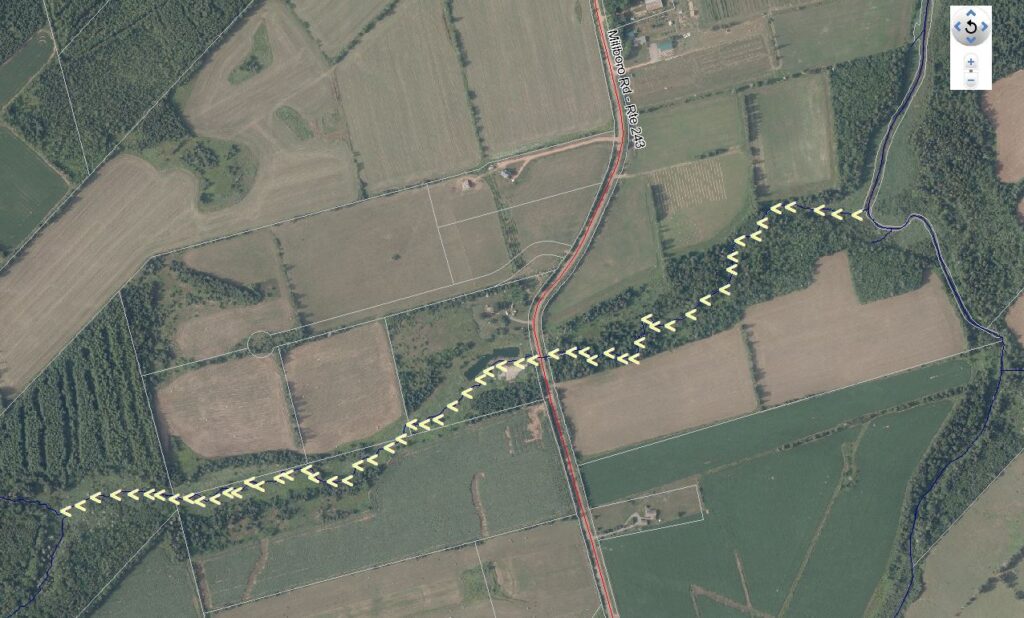
From streams to shorelines, the crew collected and discarded waste left behind on local beaches, and completed routine water quality monitoring and anoxia surveys. WRIG has been testing the quality of stream water by using a YSI to monitor the temperature, dissolved oxygen, total dissolved solids, pH, nitrates, specific conductance and salinity. Another way the crew tests the quality is by collecting a water sample and identifying macroinvertebrates. Macroinvertebrates are great bioindicators used to identify levels of pollutants in the water. This week, the crew finished sorting the samples and identifying the different macroinvertebrate classes.
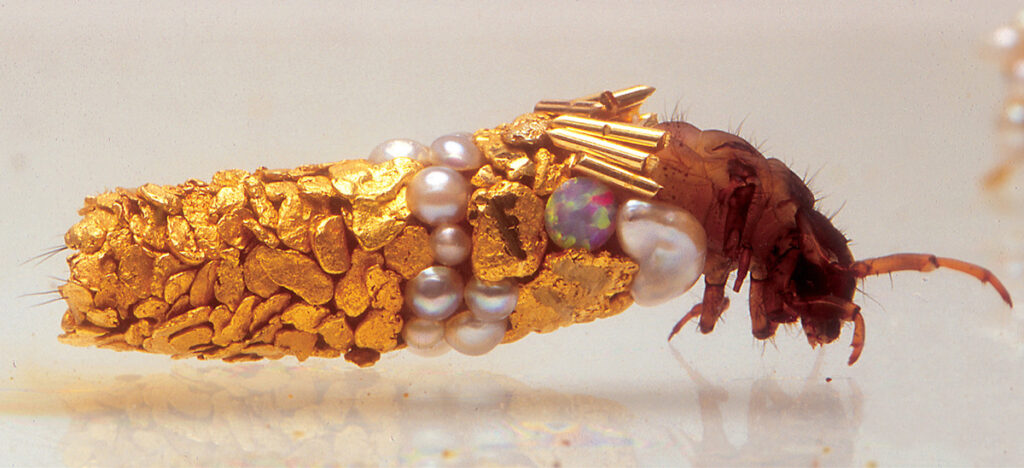
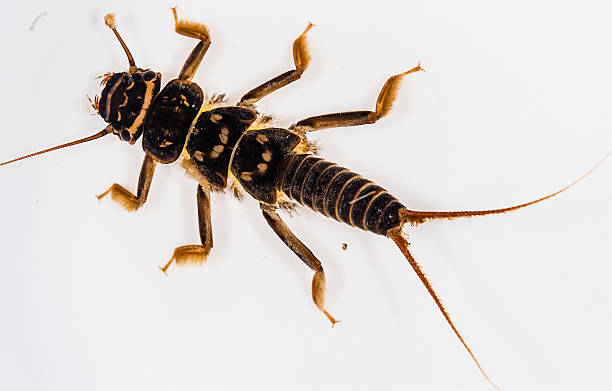

WEEK 11: July 31- August 4
The weeks are flying by and the crew is staying busy. Trees were watered, water quality checked, shorelines cleaned up, and photos were retrieved from the wildlife cameras. However, this week was mainly spent working on stream enhancement in a section of stream that drains into the Wheatley River.
Each summer, WRIG gets a permit that allows for instream enhancement and maintenance. This permit allows watershed workers to conduct instream work from June through to September. The watershed manager will have a preferred start time for work depending on the severity of blockages within the watershed, high-priority sediment removal areas, and other watershed work that is time sensitive in completion.
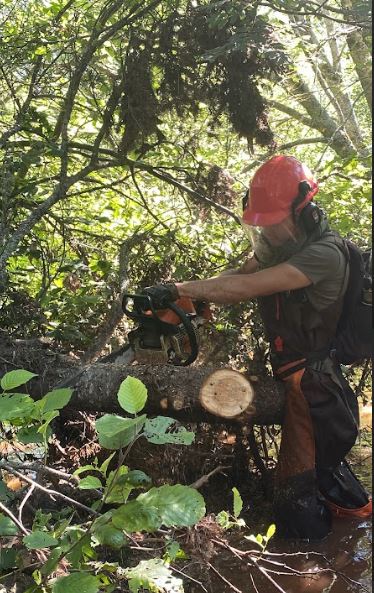
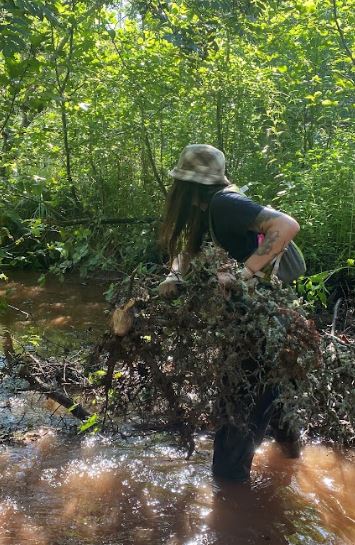
Stream work will have a starting point and an endpoint. Beginning downstream, the crew carefully enters the stream with all the necessary equipment and works their way upstream, towards that end point. As the crew heads towards the endpoint they will remove natural obstructions. Natural obstructions to watercourses may include live growth such as speckled alder, large woody debris such as whole trees, small islands, invasive plants (bittersweet nightshade), and deadfall. Many of the natural obstructions this summer are due to Hurricane Fiona. The crew will remove only materials they deem are causing a blockage. Typically this means leaving most natural material in the water, fallen trees over the banks, and being sure to not remove canopy cover.


The PEI Watershed Alliance has been working with the watershed groups advising them how to approach the mess Fiona left behind: what’s a danger to the public, what’s not ideal for wildlife populations, and what can be left where it fell. Non-natural obstructions the crew have found include household appliances, tires, and even car bodies. Unfortunately, people have used rivers and the back of fields as a place to dump unused items or garbage. Illegal dumping can hurt the environment, wildlife and communities. It’s also illegal and will result in fines.


Woody material taken from the stream gets piled along the stream bank. The crew ensures that the piles are far enough back in the riparian margin that the top branches will not re-enter the stream during high water events.
The crew works hard to remove only what needs to be removed. Nature will take care of the rest. It is important to note that even though it may look like a mess, it benefits animals, fish, insects and plants that find habitat in those spaces.
WEEK 10: July 24-28
Stream work continued this week and WRIG finished up at the first location. Along Hornes Creek, near to a water quality monitoring site, the crew worked hard to clear out blockages and obstructions that would inhibit fish passage and water flow.
Midweek, the crew performed the routine water quality monitoring and checked on a budworm tracker that they had set up earlier in the season. The budworm tracker program (BTP) is a community science tracker program. This program was created to help protect our forests. Early intervention research focuses on monitoring, detecting and treating small areas of relatively low but growing populations (hots spots) of spruce budworm before infestation or epidemic levels. Spruce budworm is a native insect that is considered by many as the most serious pest affecting the forests of eastern Canada. In an effort to curb an outbreak, researchers are testing a new approach to keep spruce budworm populations low and our forests healthy.
WRIG received a BTP kit with a pre-assembled moth trap in early summer. They hung the trap in a tree and continue to collect the trapped moths at least once per week. At the end of summer, once moths have completed their flight period, WRIG will place all collected moths and data into a pre-paid envelope and drop it off at the post office. These packages go directly to the lab where researchers can process and analyze the results.





Shoreline cleanups continued this week! The crew covered a total of 2.8 km and removed about 30 kg of trash. In the aftermath of storm Fiona, the PEI Aquaculture Alliance is partnering with the PEI Watershed Alliance to coordinate efforts to clean up our beautiful shoreline. With the support from the Department of Fisheries and Ocean’s Ghost Gear Program and Government of PEI, we’re enhancing cleanup activities for a cleaner, safer environment.
Friday, the crew completed the routine anoxia survey in the Wheatley River, checked the images on the wildlife cameras and continued on with trail maintenance at Rackham’s Community Pond.
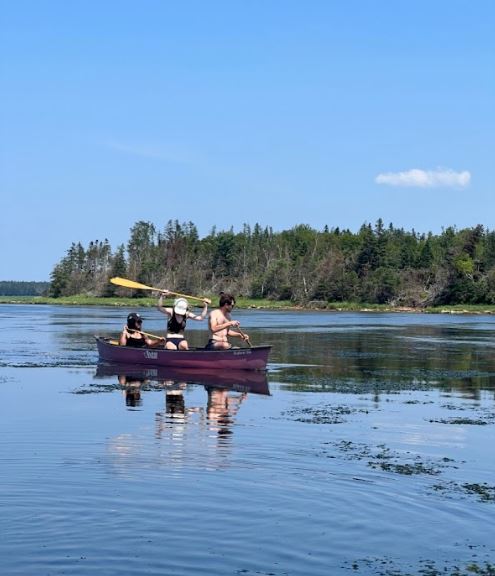
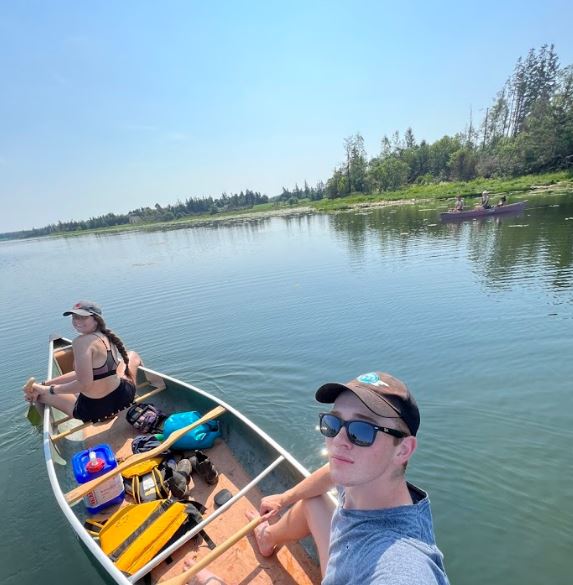
WEEK 9: July 17-21
Another busy week!
On Monday, the crew completed the weekly cleanup at Rackham’s Community Pond.
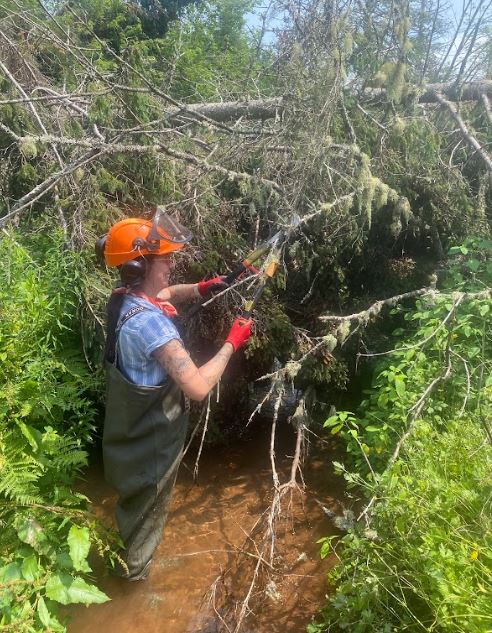
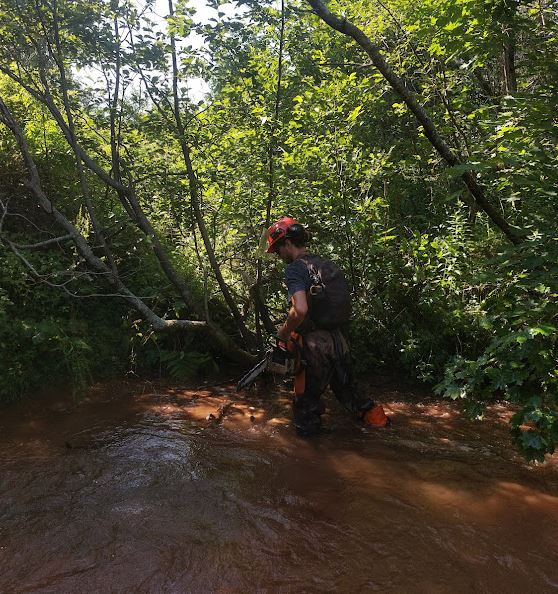
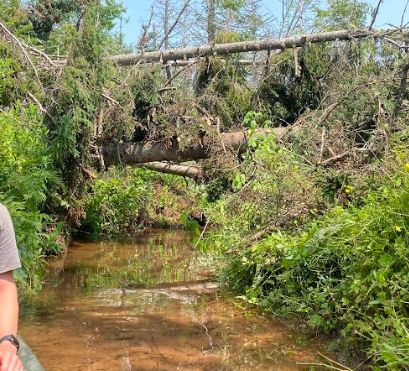
Stream enhancement began this week. The whole crew safely removed large blockages such as downed trees. Because of Hurricane Fiona, many trees have fallen into the waterways and the crew is hard at work removing the ones that inhibit fish passage and restrict flow. Trained on chainsaw, Lucas safely cuts up these trees and the crew works together to remove the debris. Habitat piles are created with this debris and placed up on the banks away from the flood plains.
The PEI Watershed Alliance hosted an Agriculture 101 course for watershed workers. At this course, the crew was given information in regards to working with island farmers. Topics included island crops, farmland protocols, rules and regulations in regards to fields near water bodies, funding opportunities and more.
The week ended with a shoreline cleanup near Barachois Beach. The crew teamed up with the Hunter Clyde Watershed Group and removed about 20 kg of trash along 300 m of shoreline. At this site, the crew removed items washed ashore after Hurricane Fiona as well as trash left behind from beach visitors. Shoreline cleanups are important. We hope that through awareness and education, people will work together to take care of our coastlines and not leave behind waste.
WEEK 8: July 10-14
The crew started the week off by going to clean up the community pond in Wheatley River. Rackham’s Pond has historical significance and is an area that often brings the community together. It is here that you can find local anglers, partake in the annual duck race, have picnics, and walk the beautifully maintained trails.
Rackham’s Pond was once a watermill that provided important economic and social benefits to the community. While water-powered lumber, flour, wool, and electricity mills have since disappeared on PEI, many millponds continue to be important historic and recreational sites. At least four mills are known to have harnessed the power of the Wheatley River, one of which formed Rackham’s Pond.
In 1892, a resident farmer dammed the Wheatley River and built a grist mill. Four years later, in 1896, the White farm, the Mill, and the Pond were purchased by John Rackham. The grist mill and pond were a main focal point for social, recreational and commercial activity for the residents of Ebenezer, Bungay, Oyster Bed, Rustico and Wheatley River until 1978, when the pond breached its banks and the basin emptied.
The pond and its riparian area have been leased to WRIG. The crew begins each week by heading to the pond to mow & snip the picnic area, weed the garden, empty the garbage and ensure that the area can be enjoyable for all.
Other activities that took place this week included tree planting in Oyster Bed, Beach Hut, water quality monitoring, wildlife camera check, and an anoxia survey in the Wheatley River.
WEEK 7: July 3-7
This 4 day week was jam-packed with all sorts of different activities!
The week started off with the majority of the crew taking a First Aid course which was put on by the Red Cross. We became certified and trained in responding to emergency situations and injuries that could arise day to day or in the field.
Patrick and Amber (who were already First Aid certified), attended the first Beach Hut of the season. Teaming up with Jack and Emma from the Hunter-Clyde Watershed Group, the crew presented to the public at Cavendish Beach the importance of native tree and shrub species in PEI.
Water quality monitoring took place as scheduled on Wednesday, and on Thursday the crew attended a Watershed training course at the Farm Center located in Charlottetown. The training course was led by Mary Finch and many island watershed crew members attended. Topics covered included work safety, native fish species, stream ecology, and more. Once the classroom session was completed, the group split into 2 and went to either West River or Cornwall for the field component.
Friday was hot, hot, hot! The morning was spent reviewing wildlife camera photos. As per usual, we saw American robins, common grackles, and our favourite family of raccoons. After that, the crew took to a section of the Millboro stream to identify plant species growing in the riparian area.



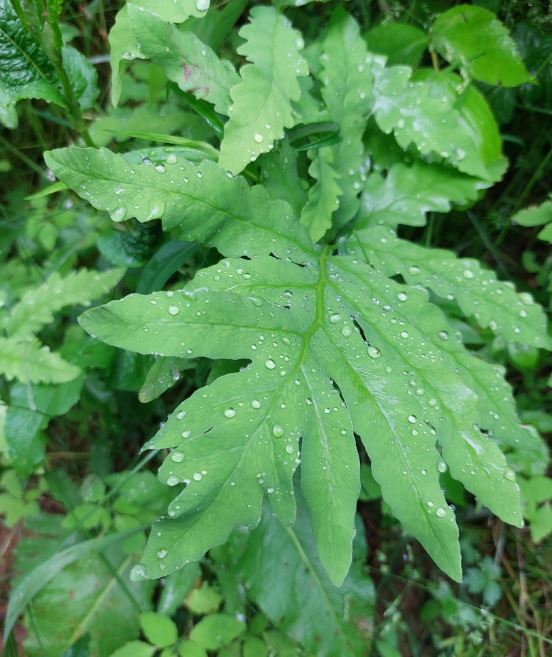
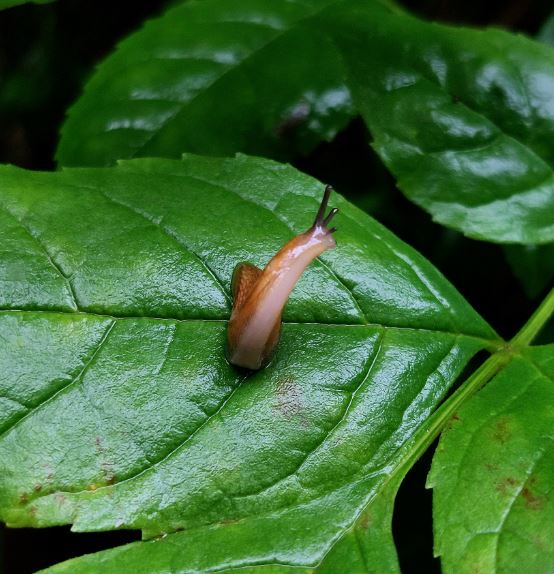

To wrap the week up, the crew returned to this season’s tree planting sites to live stake using Red Osier Dogwood. It was planted along the stream banks to help with erosion control and enhance biodiversity.
WEEK 6: June 26-30
HAPPY CANADA DAY!
Woo-hoo! The whole crew is now here. This week we welcomed Amber. Amber is joining us as a watershed technician and is a recent graduate from École François Buote. Welcome to the team.
The last week of June and the last site for tree planting. The crew worked hard and fast and successfully planted a total of 457 native tree and shrub species within the watershed. The trees and shrubs were planted at 3 large sites this year. The sites were chosen as high-priority areas in order to enhance buffer zones and reduce sediment runoff. Now that the trees have been planted, WRIG will return weekly to ensure they are watered and doing well.
The rain barrels have arrived! Thanks for everyone who participated in the Spring Into Summer Event. Rain barrels that were pre-ordered can be picked up at WRIG’s office and we still have a few for sale!
Other activities that took place this week were macroinvertebrate sorting, checking wildlife camera photos, the bi-weekly anoxia survey in the Wheatley River, and preparing for the Canada Day event in North Rustico.
WRIG and HCWG teamed up in North Rustico for the Canada Day event where we held a tree drive. Native tree and shrub species are given to community members and donations to the groups were made. It was a lovely way to spend a celebrated holiday and we hope you all had a wonderful Canada Day!
WEEK 5: June 19-23
Have you ever been curious about what is living in the streams and rivers in PEI? Well, our crew is!
Using magnifying glasses and a microscope, we started looking through water samples collected from our watershed. If you look really closely, you’ll be able to see all the different types of macroinvertebrates that inhabit freshwater environments. Macroinvertebrates are important bioindicators. They directly represent the health of the streams and rivers! Part of being a watershed technician includes finding the macroinvertebrates in the water samples and recording and counting the different species we find.
The crew carried on tree planting and watering this week. Once the trees and shrubs have been planted, the crew continues to care for them by returning to the sites to water them. Once the trees were taken care of, the crew began their rescue mission for the now sunken, floating wetland island. Working together the crew successfully removed the island from the bottom of Rackham’s pond. It was a muddy job, but now they can breathe a sigh of relief knowing the island is safe. The next step will be to repair and replant the island so it can return back to the pond and float once more!
Each Friday, the crew retrieves the SD cards from 2 wildlife cameras within the watershed. Back at the office, the crew reviews the images at each site looking for signs of river otter. So far, we have no river otters but take a look at some of the staff favorite shots!










WEEK 4: June 12-16
Here we are, at week 4. Time flies when you’re having fun!
Tree planting started this week and the crew planted 190 native tree and shrub species at Rackham’s Pond. Once the trees had been planted the crew placed tree guards on them to protect them from being browsed on by rodents and hare in the area. The crew will return to the site a few times a week to water the newly planted tree and shrubs to help increase the success rate of growth.
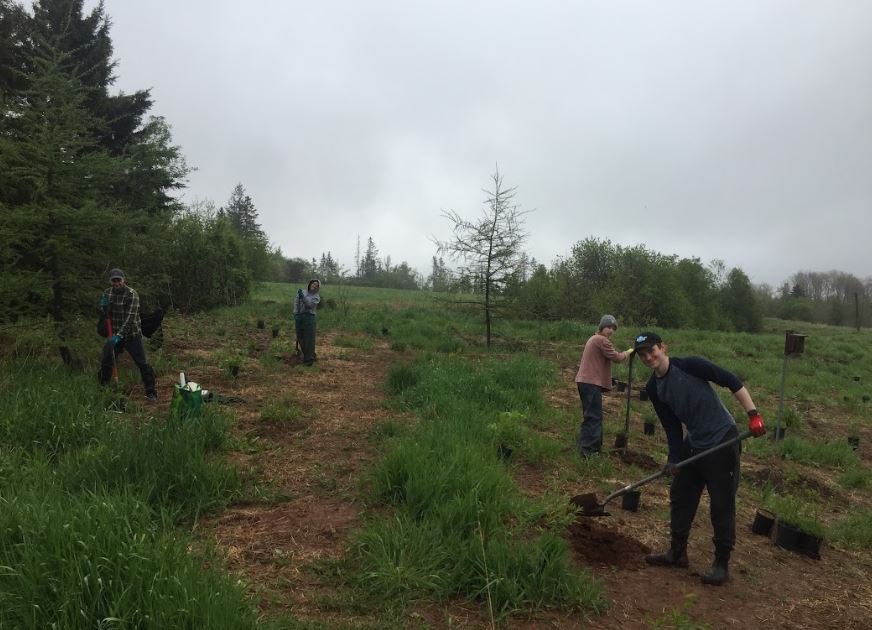
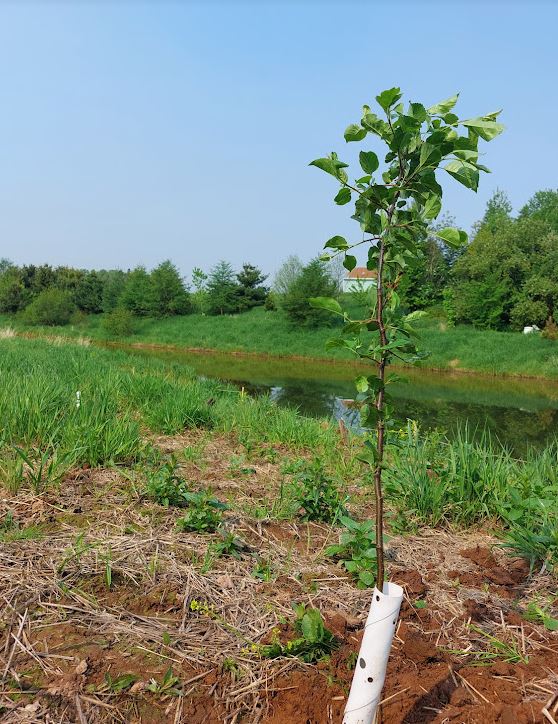
Midweek, the crew took the stream banks in search of cattails. Cattails were collected and transplanted onto a floating wetland island that was installed last fall at Rackham’s Pond. It was muddy work, and the team worked hard to secure the cattails in place with mud. Once all the cattails were planted, the crew relaunched the floating wetland island into the pond. Unfortunately, with the extra weight of the mud used to hold the cattails in place, the island sank. The crew felt quite defeated as they watched the cattails slowly become submerged underwater. Do not worry though, a recovery plan has been made and the crew will begin the rescue mission soon!



The week wrapped up with WRIG’s Spring into Summer event on Saturday held at the Cymbria Lions Club. At this event, trees, nest boxes, and milkweed seeds were available to community members who graciously donated to WRIG. The event was a success. Many native tree and shrub species were given out to the community. We would love to give a big THANK YOU to everyone that attended and donated. We appreciate it very much!
WEEK 3: June 5-9
The crew filled the week with activities such as maintenance at Rackham’s Pond, routine water quality monitoring, checking the trail camera photos and prepping for an upcoming event. With Environmental Fun Day approaching quickly, WRIG was working hard this week to prepare.
The school year is almost over and the students are ending it with some field trips! One of those field trips includes our annual event hosted by WRIG and our neighbouring watershed, Hunter-Clyde Watershed Group. Each year, over 100 students from different schools in grades 5 and 6 visit us to learn about nature, in nature! This year we welcomed presenters from across PEI: from the Bedeque Bay Environmental Management Association, PEI Watershed Alliance, Island Falconry Service, PEI Fish and Wildlife, and PEI Provincial Tree Nursery.
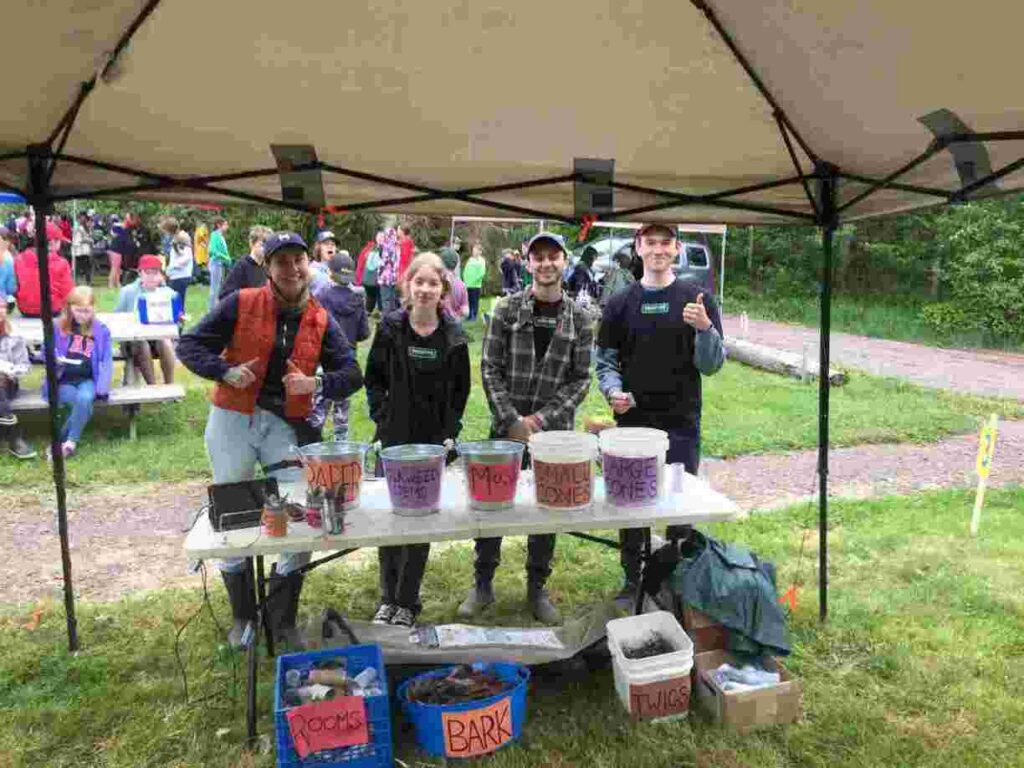
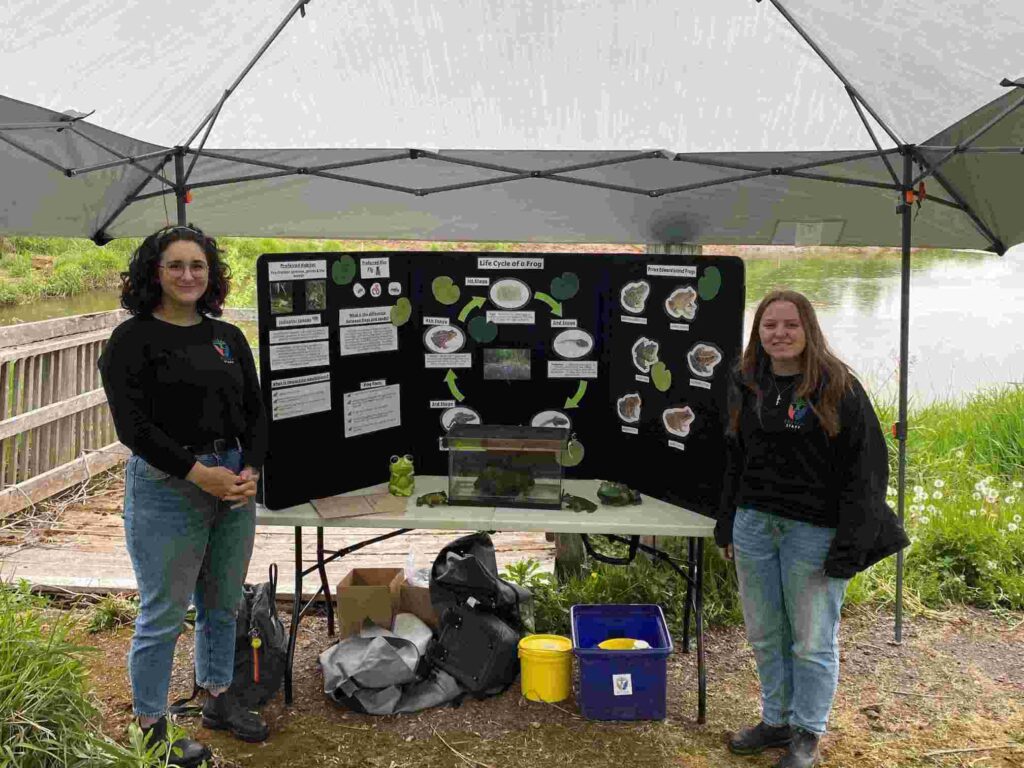
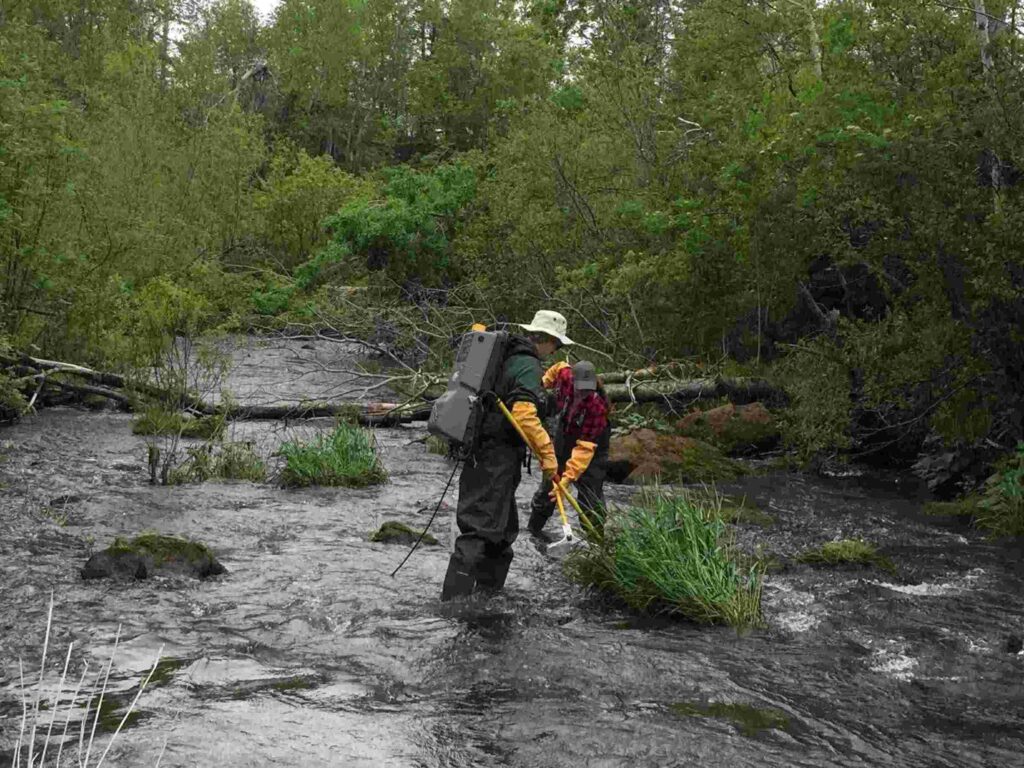
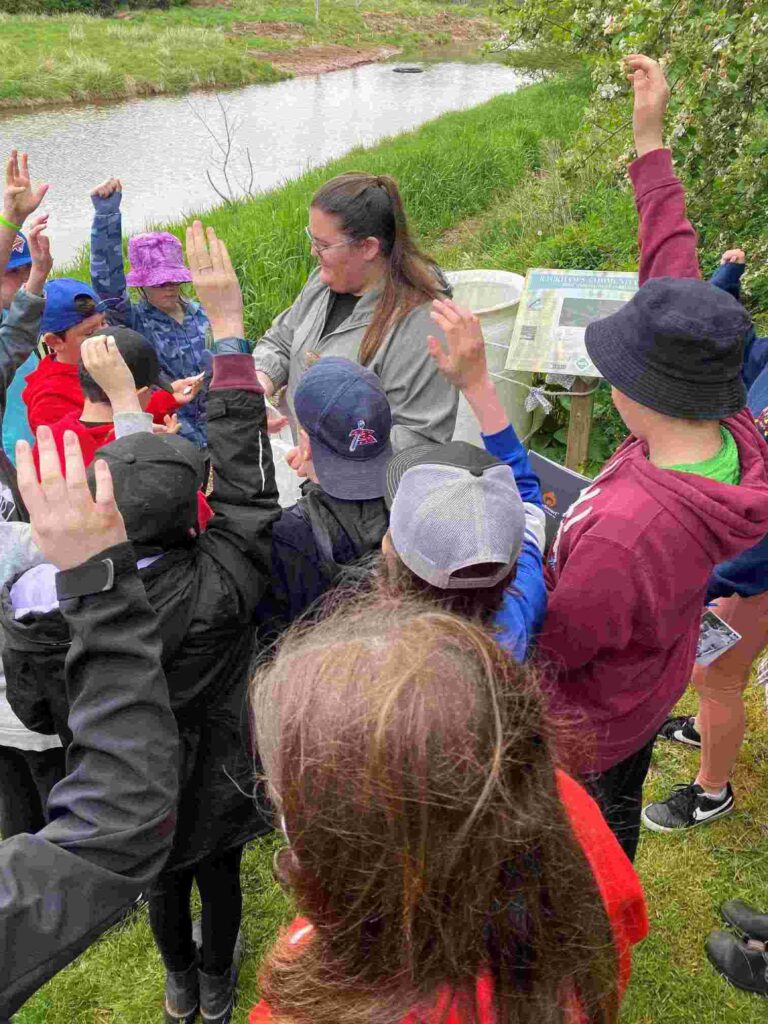
This year, WRIG presented on Pollinators & Bug Hotels. The crew designed and built their very own bug hotel to be installed at Rackham’s Pond in the pollinator garden. The students participated by assembling a “room” for the hotel. Each room was created using a toilet paper roll and stuffed with an assortment of natural materials (bark, moss, stems, twigs, cones, etc.). Robyn and Lucas taught the kids the important roles insects have in the environment and guided them through the steps of creating bug hotels.
So why was WRIG building a bug hotel for the pollinator garden?
Insects are an important part of the ecosystem and do all sorts of useful things for us! They pollinate our flowers and gardens. They help break down organic material and debris. Insects are an important food source for other wildlife. Bug hotels can be used in big backyards, tiny yards or even on balconies. They can be placed on fences, trees, bushes, or on the ground. A bug hotel can become a home for bees, ladybugs, beetles, butterflies, spiders, flies and much more!
Interested in building your own bug hotel? You can follow these simple steps. Remember, bee creative!


WEEK 2: May 29-June 2
June has arrived and time flies when you’re out in the field!
The week began with the crew down at Rackham’s Pond. Together they mowed, snipped, pulled weeds, and picked up litter. If you have had the chance to visit Rackham’s Pond recently, you may have noticed three cold water refuge pools that were created last fall. During this process, some of the vegetation was disturbed. Do not worry though! The WRIG crew has been hard at work protecting and enhancing the banks of the pond. This includes roping off the area to reduce foot traffic to prevent further damage to the bank, spreading and watering various native grass/grain seeds, and routine water quality monitoring.
The weather became nicer and the crew conducted tree swallow nest box surveys. Using binoculars, tree swallow activity is recorded for all the tree swallow nest boxes in the watershed.







Tree swallows and other bird species spotted while conducting nest box checks: yellow-throated warbler, Canadian Goose, red eyed vireo, yellow warbler and an osprey!
Midweek, WRIG’s trees arrived. A total of 730 native tree and shrub species were provided from the provincial tree nursery. Once the trees and shrubs were all unloaded, the crew hit the road to begin the weekly water quality monitoring of the watershed. One of the ways water quality can be tested is by collecting macroinvertebrates from the streams. Macroinvertebrates are great bioindicators and can tell you a lot about the health of the stream. The crew collected 5 samples from different streams using the kick net method. The samples are stored away for sorting on rainy days at the office.
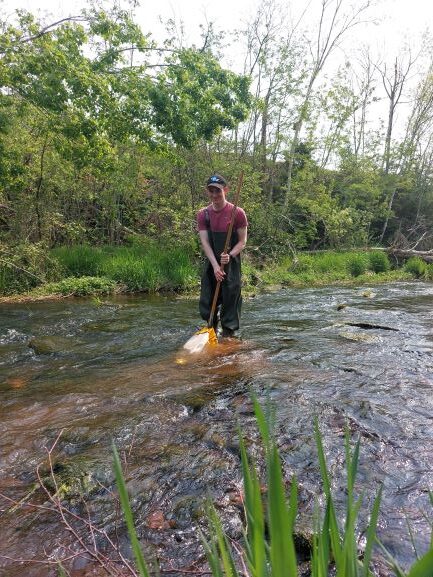
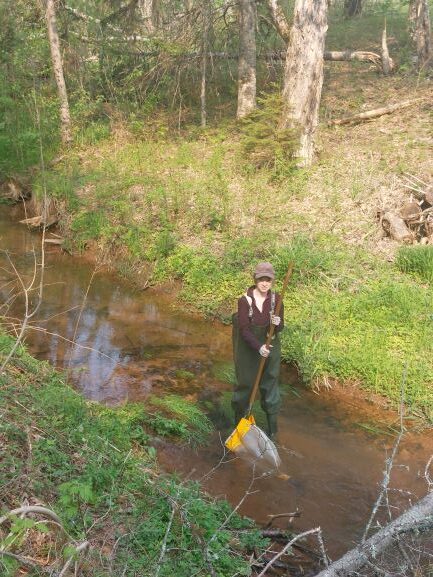
Patrick and Katie collecting macroinvertebrate samples using a kick net
The week wrapped up with the first anoxia survey of the season. Lucas, Payton, and Katie set out by canoe to monitor the Wheatley River for signs of anoxia. The data is recorded and shared with the Atlantic Data Stream.
WEEK 1: May 22-26
The 2023 season has officially begun!
This year, we are welcoming Lucas (Field Supervisor), Payton (Intern), Patrick and Katie (Watershed Technicians) to the WRIG team. Maggie (Watershed Manager) and Robyn (Project Lead) have spent the winter and spring preparing for the upcoming season and are excited for what this summer has in store!
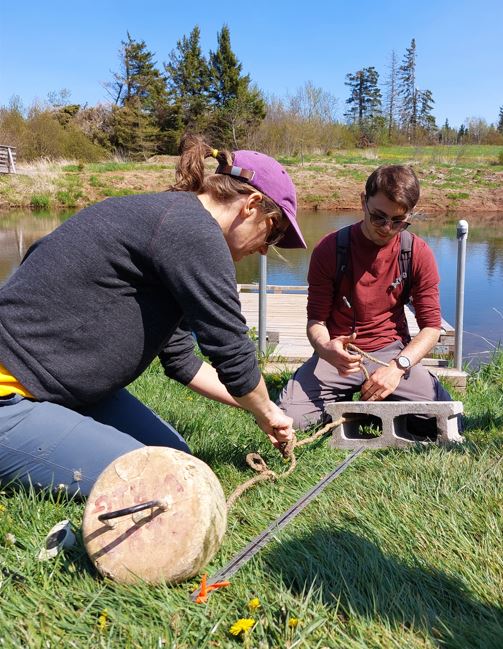
The week started out with orientation followed by setting up and deploying 3 temperature loggers around the Wheatley River watershed area. Anchored to a cement block and tied to a buoy, the temperature loggers will monitor the water’s temperature every hour throughout the summer season. Collecting this information is important as it affects fish habitat.
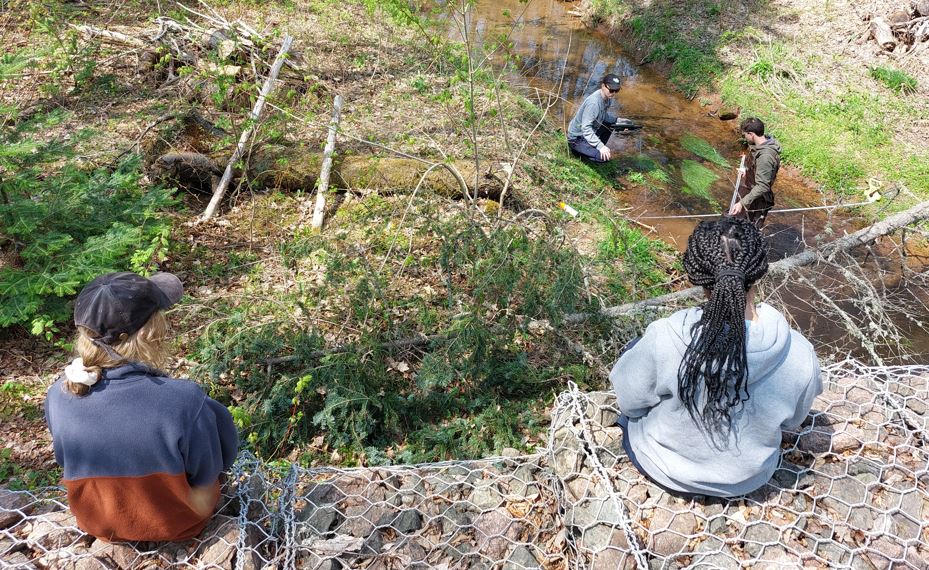
Later in the week, the fish ladders were visited to ensure that there are no obstructions. However, at one of the locations an old spruce tree was stuck. The crew worked together and safely removed it. Yay, go team!
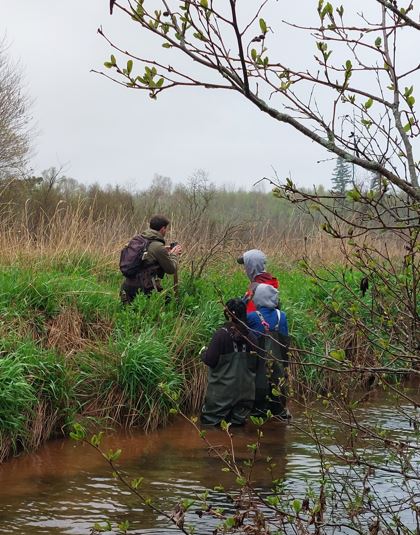
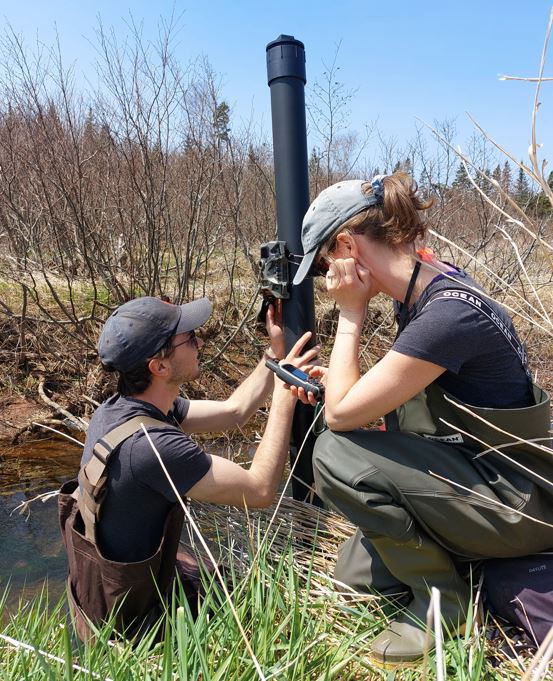
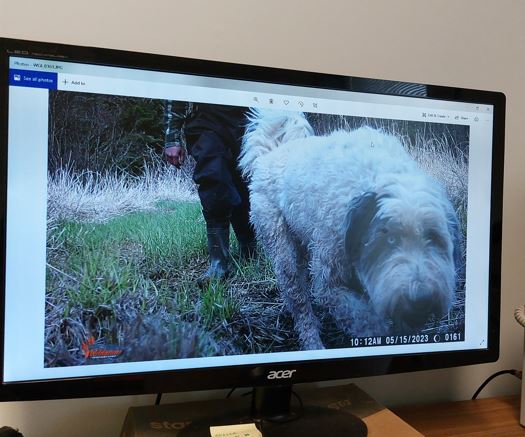
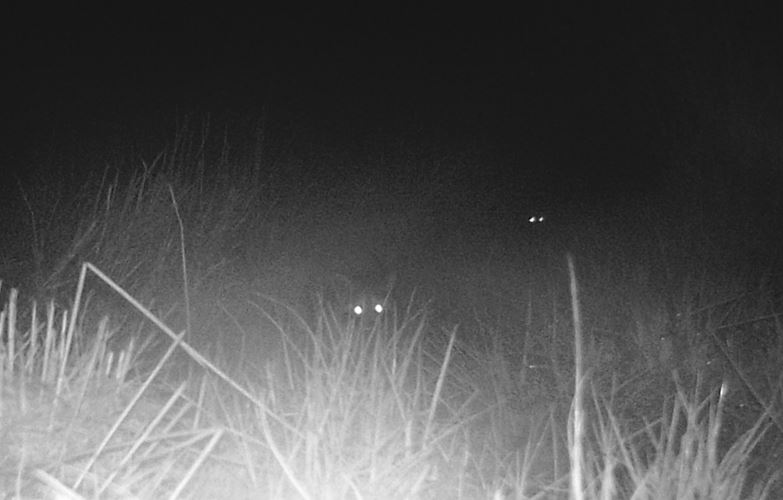
This week has been a great start to the season, and we can’t wait to see what the rest of the season brings.
